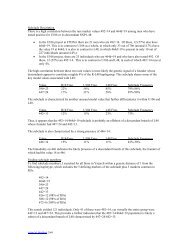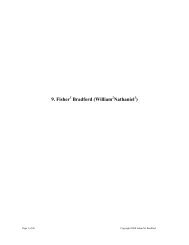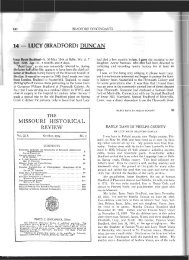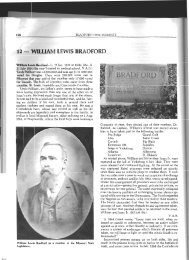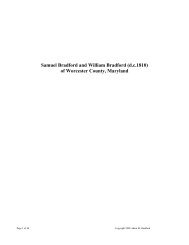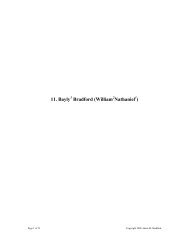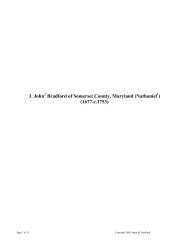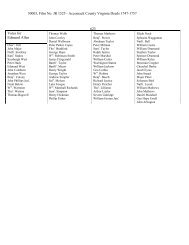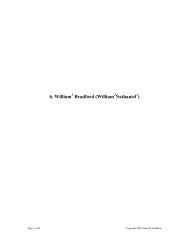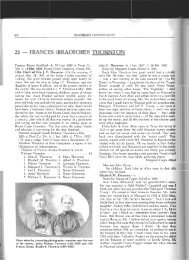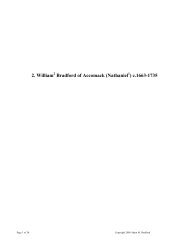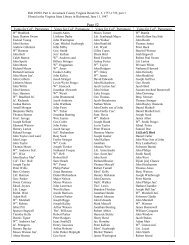1. Nathaniel Bradford of Accomack County, Virginia - Lower ...
1. Nathaniel Bradford of Accomack County, Virginia - Lower ...
1. Nathaniel Bradford of Accomack County, Virginia - Lower ...
You also want an ePaper? Increase the reach of your titles
YUMPU automatically turns print PDFs into web optimized ePapers that Google loves.
<strong>Nathaniel</strong> in the Late 1660’s: 1666-1670<br />
Addition to Plantation at Matchipungo<br />
On 9 October 1667, <strong>Nathaniel</strong> received a patent for 400 acres adjacent to the 2400 acres he already held at<br />
Matchipungo. 116 This acquisition brought the total size <strong>of</strong> <strong>Nathaniel</strong>’s plantation to 2800 acres, or almost 4<br />
½ square miles. This was large in comparison to the size <strong>of</strong> most plantations in <strong>Accomack</strong>, and more than<br />
enough acreage than was necessary for a single household. To what uses did <strong>Nathaniel</strong> put this land?<br />
Though there is no direct evidence <strong>of</strong> it, he likely planted tobacco, as did nearly every landowner in<br />
<strong>Virginia</strong> at the time. At his death <strong>Nathaniel</strong> owned such large numbers <strong>of</strong> sheep and cattle that it is fair to<br />
imagine that a sizeable portion <strong>of</strong> his plantation was used for grazing. 117 <strong>Nathaniel</strong> may have had gardens to<br />
supply his household with vegetables and orchards to supply it with fruit and cider. At certain points in his<br />
life <strong>Nathaniel</strong> likely had tenants on his land 118 and possibly houses for servants and slaves. Some portion <strong>of</strong><br />
<strong>Nathaniel</strong>’s plantation would have also been used by the Indians who resided on his land, though it is<br />
unknown how much land they used and unclear where precisely on the tract their land was located.<br />
Map <strong>of</strong> modern-day <strong>Bradford</strong>’s Neck, depicting rough boundary <strong>of</strong> <strong>Nathaniel</strong>’s Matchipungo Plantation<br />
<strong>Nathaniel</strong>’s home was probably located in the north <strong>of</strong> the tract near present day <strong>Bradford</strong>’s Bay and a little<br />
to the south <strong>of</strong> the town <strong>of</strong> Wachapreague. The house doesn’t survive, but according to Ralph Whitelaw it<br />
is possible a portion <strong>of</strong> it existed in his day as a room in the Gulf Stream Nursery. 119 Living on <strong>Nathaniel</strong>’s<br />
plantation in 1667 were at least 9 individuals, a number arrived at through examination <strong>of</strong> the list <strong>of</strong> taxable<br />
inhabitants in <strong>Accomack</strong> <strong>County</strong> for that year. Tax lists survive for <strong>Accomack</strong> <strong>County</strong> from the year <strong>of</strong> its<br />
formation until 1695, with the exception <strong>of</strong> the years 1672 and 1673. These lists contain the name <strong>of</strong> every<br />
head <strong>of</strong> household, as well as the number <strong>of</strong> taxable individuals in each person’s household, and are an<br />
invaluable source for researching the lives <strong>of</strong> particular individuals as well as their relation to their<br />
neighbors.<br />
Page 23 <strong>of</strong> 74 Copyright 2008 Adam M. <strong>Bradford</strong>




